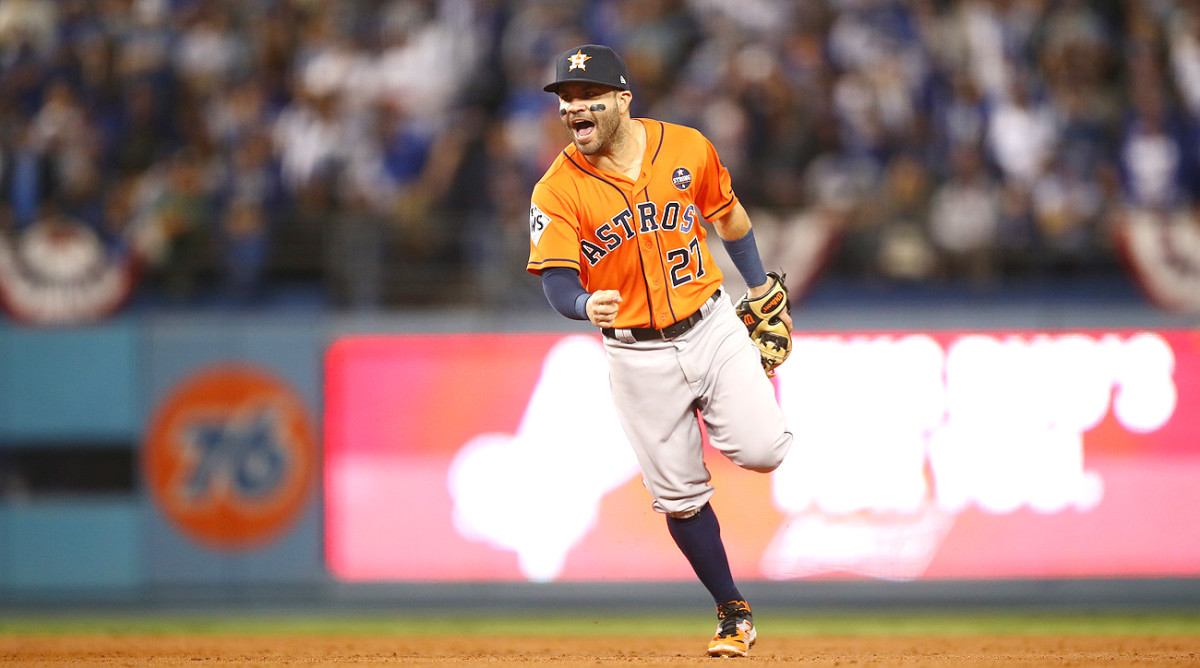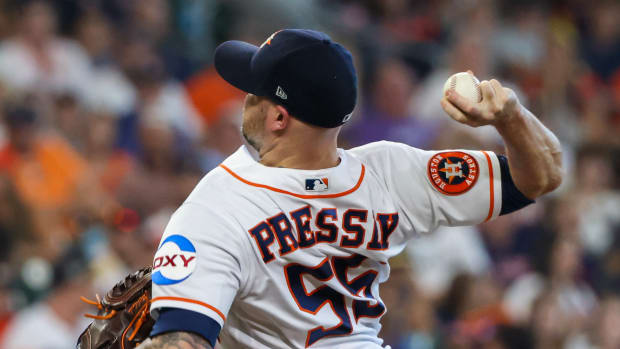Jose Altuve is Still the King, but Second Base is Getting Stronger in Fantasy Leagues

Second base is no longer a fantasy black hole. It features an annual star and former MVP in Jose Altuve, a near-MVP and rising sensation in Javier Baez, and one of the league’s premier rate/speed specialists in Whit Merrifield. It has a couple of surefire investments at their expected draft-day price tags in Scooter Gennett, Travis Shaw and Daniel Murphy. As we discussed in our Boring All-Star Team column Robinson Canó is wildly underappreciated at this stage of his career. Jonathan Villar and Dee Gordon can both still steal a ton of bases, certainly enough to overlook some of their obvious warts. Altuve and Baez are the only do-it-all players at the position, but every owner can find something he or she needs at second base.
With that said, there are still some questions at the position. One concerns a player down in Atlanta who looked like he was going to be an immediate superstar before suffering through a dreadful second half. Another one in Chicago has hinted at a breakout the last two seasons, but hasn’t quite arrived just yet. We’ll discuss both of those players in depth, and get into the very back end of the position hunting for sleepers, in our second base primer.
Three Burning Questions
1. Who’s the real Ozzie Albies?
If baseball seasons were one month long, Ozzie Albies may have an NL MVP trophy on his mantle at home. Albies entered 2018 as a chic breakout pick, and everyone who bought in started taking their victory laps in April. The second baseman hit .293/.341/.647 with nine homers in the first month of the season, a pace that was clearly unsustainable, but suggested that the Braves had their next great infield star. The huge month helped Albies earn an All-Star nod in his first full season, slashing .281/.318/.516 with 20 homers, 29 doubles, 55 RBI and nine steals in the first half.
Everything fell apart for Albies in the second half, and, really, his downturn started earlier than that, as the two slash lines in the paragraph above indicate. Albies hit .226/.282/.342 with four homers, 11 doubles and 17 RBI after the All-Star break. His .274 wOBA in the second half was the ninth-worst in the majors, lower than players such as Jorge Bonifacio and Yolmer Sanchez. Albies was barely playable in fantasy lineups for much of the second half of the season, a far cry from where he began the year.
Which Albies is the real version? Albies isn’t coming at much of a discount considering how he hit in the second half, with his average draft position of 51.51 placing him in the middle of the fourth-round of a standard draft. Even with the rate concerns engendered by his second-half slide, that’s a fair price depending on what you do in the first three rounds.
Let’s first consider some of what we should think of as near-guarantees for Albies. The power power/speed combo he showed last year is legitimate, and every projection system agrees with that statement. No matter which one you prefer, they all have him going for somewhere between 19 and 21 homers, and 16 and 21 steals. That’s a great foundation for fantasy success, so long as the rates aren’t abysmal.
Speaking of those rates, there’s good reason to think Albies can be a .270/.330 hitter this season. Last year, Albies had a 21.3% line-drive rate, 38.8% ground-ball rate, 39.9% fly-ball rate, 17% strikeout rate and 5.3% walk rate. Take those batted-ball stats and add in that Albies is a switch hitter with speed, and it seems likely that he should have done better than his .285 BABIP. Luckily, we have a reliable way of measuring that. According to xStats, the best spot on the web for expected stats based on publicly available data, Albies had an xBABIP of .302, and an expected slash line of .277/.319/.474.
With some regression to the mean and growth expected for a player in his second full and age-22 seasons, Albies slash line should trend in the right direction, with his rates certainly high enough to not detract from what he offers in terms of power and speed.
Then, there are the other counting stats. Even as he sputtered in the second half, Albies finished last season with 105 runs and 72 RBI. He spent most of last year hitting first or second, and that could change this year with Ronald Acuña locked in, at least to start the season, as the leadoff man, and Josh Donaldson likely to hit second. Albies will begin the year in the middle of the order, likely fifth behind Freddie Freeman and Nick Markakis. That gives him huge RBI upside, especially if he can approach or surpass 25 homers.
If he eventually moves to the top of the order in front of Freeman, Markakis and Donaldson, and possibly even Acuna, he’d be among the favorites to lead the league in runs, at least on a per-game basis from that spot. Put all of this into one package, and Albies is worth what it’ll cost to get him on draft day, even knowing the obvious risks.
BELLER: First Base Primer and Rankings
2. Is the Yoan Moncada breakout upon us?
The baseball world has expected Yoan Moncada to be a full-fledged superstar since he entered the 2016 season as a consensus top-10 prospect. That only intensified when he made his MLB debut that year, then started 2017 as a consensus top-five prospect after being the centerpiece of the deal that changed Chris Sale’s Sox from White to Red. In two years with the White Sox, Moncada hasn’t quite taken off, hitting .234/.301/.403 with 25 homers and 40 doubles in 881 plate appearances, which translates to about 1 1/4 full seasons. If this is going to be his year, he’s going to have to make at least a few adjustments.
Before we get too deep into this, let’s acknowledge that last year was Moncada’s first full MLB season and that he turns 24 at the end of May. It’s perfectly healthy for Moncada to be experiencing growing pains at this stage of his career, no matter his pedigree or upside.
OK, back to the burning question. Moncada’s biggest problem is obvious. He strikes out way too much. He led the majors with 217 strikeouts last year, fanning in 33.4% of his plate appearances. Only Chris Davis and Joey Gallo had higher strikeout rates last season. However, Moncada’s isn’t an issue of plate discipline or a bad sense of the strike zone, as is often the case with young players. He swung at 22.2% of pitches outside the zone that he saw last year, the 15th-lowest rate among the 140 players who qualified for the batting title. He kept some awfully lofty company in this regard, with Joey Votto, Alex Bregman, Mookie Betts, Mike Trout, Matt Carpenter and Jose Ramirez also among the bottom-15 chasers last season. Moncada’s 12.2% whiff rate was higher than league-average, but certainly not prohibitive by any means.
Moncada’s problem was that he was overly selective, letting too many hittable pitches go by rather than ambushing them when he had the chance. Moncada swung at 62% of pitches in the strike zone he saw, which tied him for 99th in the majors. It takes a special breed of player to take 38% of the strikes he sees and still find enough hittable pitches to do meaningful damage. Of the players in the top 50 in the league in wOBA, 19 had a lower swing rate on strikes than 62%. Eleven of those 19 were in the top 20, and six were in the top eight, including Trout, Betts, Bregman, Ramirez, Christian Yelich and Paul Goldschmidt. Basically, if you can swing at that few strikes and still get by, you’re a baseball freak. Moncada might be there one day, but the best thing he can do for himself this year is get more aggressive on pitches in the zone. If he does that, his star turn may arrive.
BELLER/SHAPIRO: Is Xander Bogaerts or Gleyber Torres the Better Fantasy Player?
3. Who do you target if you wait…and wait…on this position?
The ellipses and second “and wait” should tell you that we’re reaching really deep on this one, definitely outside the top 200 picks. At pick No. 200 in a typical draft, 19 second basemen are already off the board, meaning most people will have already found their starter, or at least the player who will begin the year as their starter. Rather than reaching for someone like Jonathan Schoop or Joey Wendle, take a shot on some real upside with Lourdes Gurriel.
Gurriel will begin the year as Toronto’s starting shortstop, though he qualifies at second base in fantasy leagues and could spend some time at second with Freddy Galvis taking over at shortstop. Gurriel should hit at or near the top of the order after an impressive rookie season in which he hit .281/.309/.446 with 11 homers, eight doubles and 35 RBI. He lost significant time in the second half to ankle and hamstring injuries, but he enters spring fully healthy and ready to remake Toronto’s infield, whenever the team decides to stop manipulating service time and promote Vlad Guerrero Jr.
There’s a lot to like about Gurriel, but my favorite thing is how he performed as the season progressed and the league, at least theoretically, got more of a look at him. After a slow start to the year that got him sent to Triple-A Buffalo for a few weeks in late June, he slugged .648 in 73 plate appearances in July. He missed more than a month because of his ankle injury, then returned in late August and slugged .439 over his final 89 plate appearances of the season while nursing a hamstring injury that would cause the Blue Jays to shut him down with one week left in the year. If I miss out on the top few tiers at the position, I’m more than happy to sit back, focus on other spots, and use a pick outside the top 200 on a guy with plausible upside to be one of the 10 best fantasy second basemen in the league this year.
2019 Fantasy Baseball Rankings powered by FantasyProsECR ™ - Expert Consensus Rankings
ADP - Average Draft Position



































